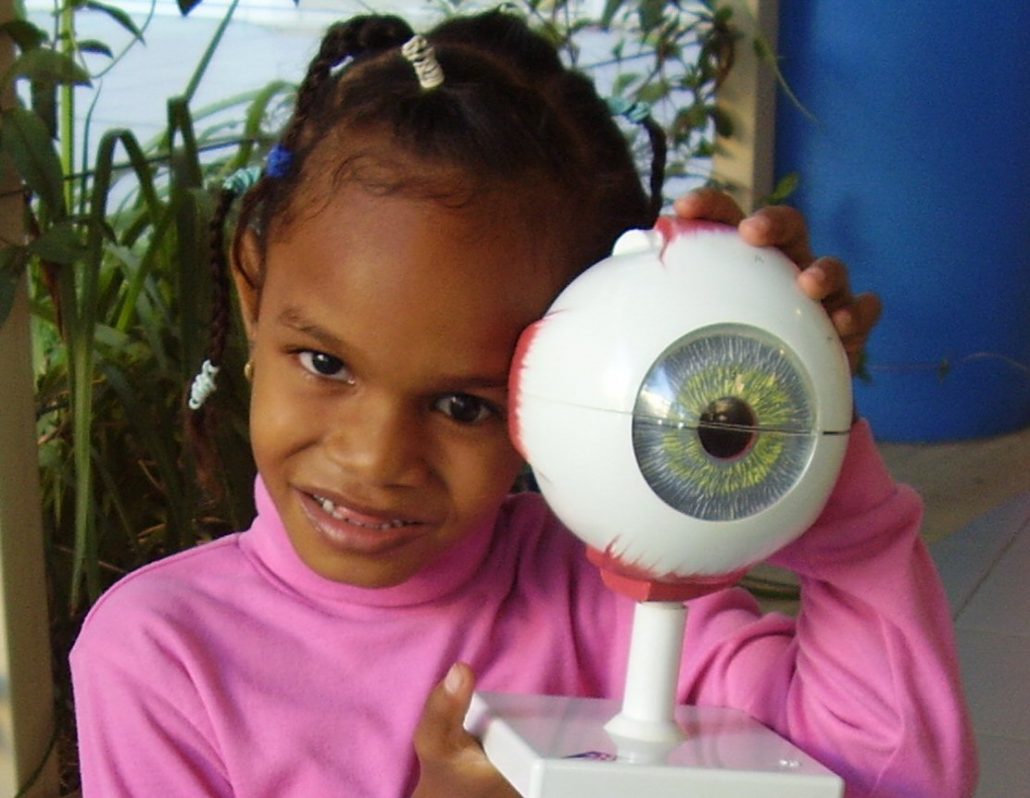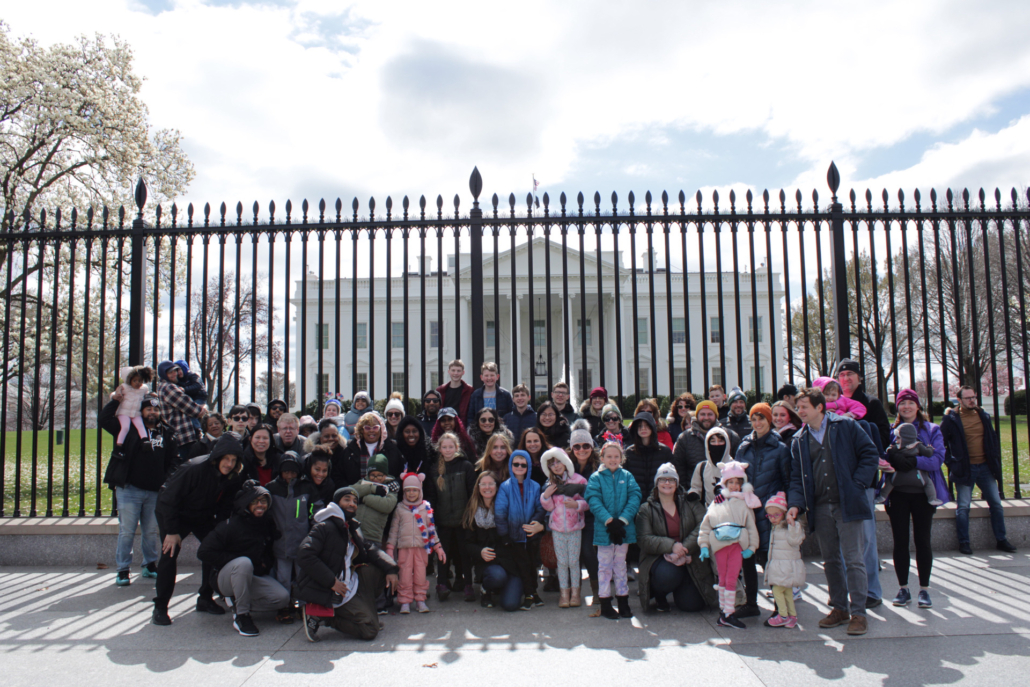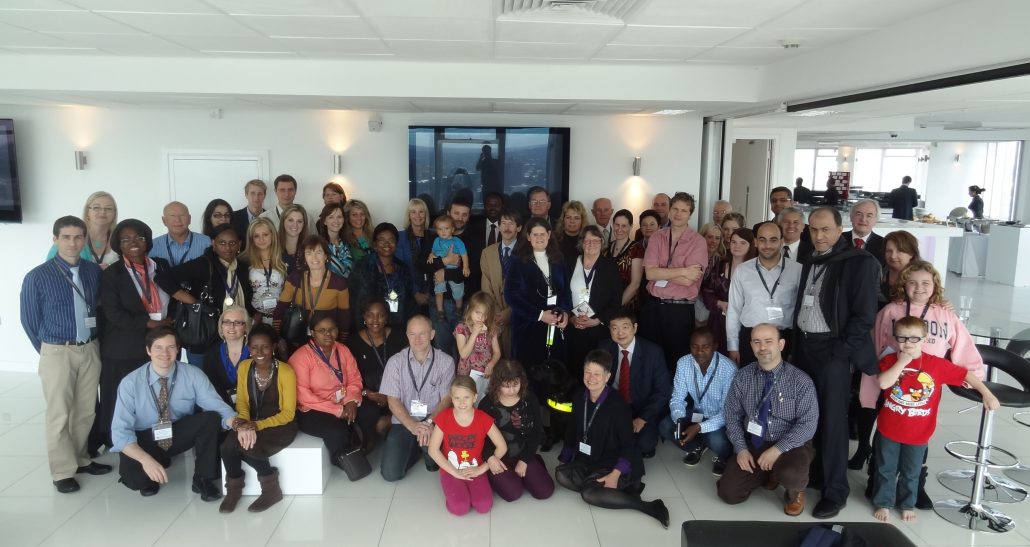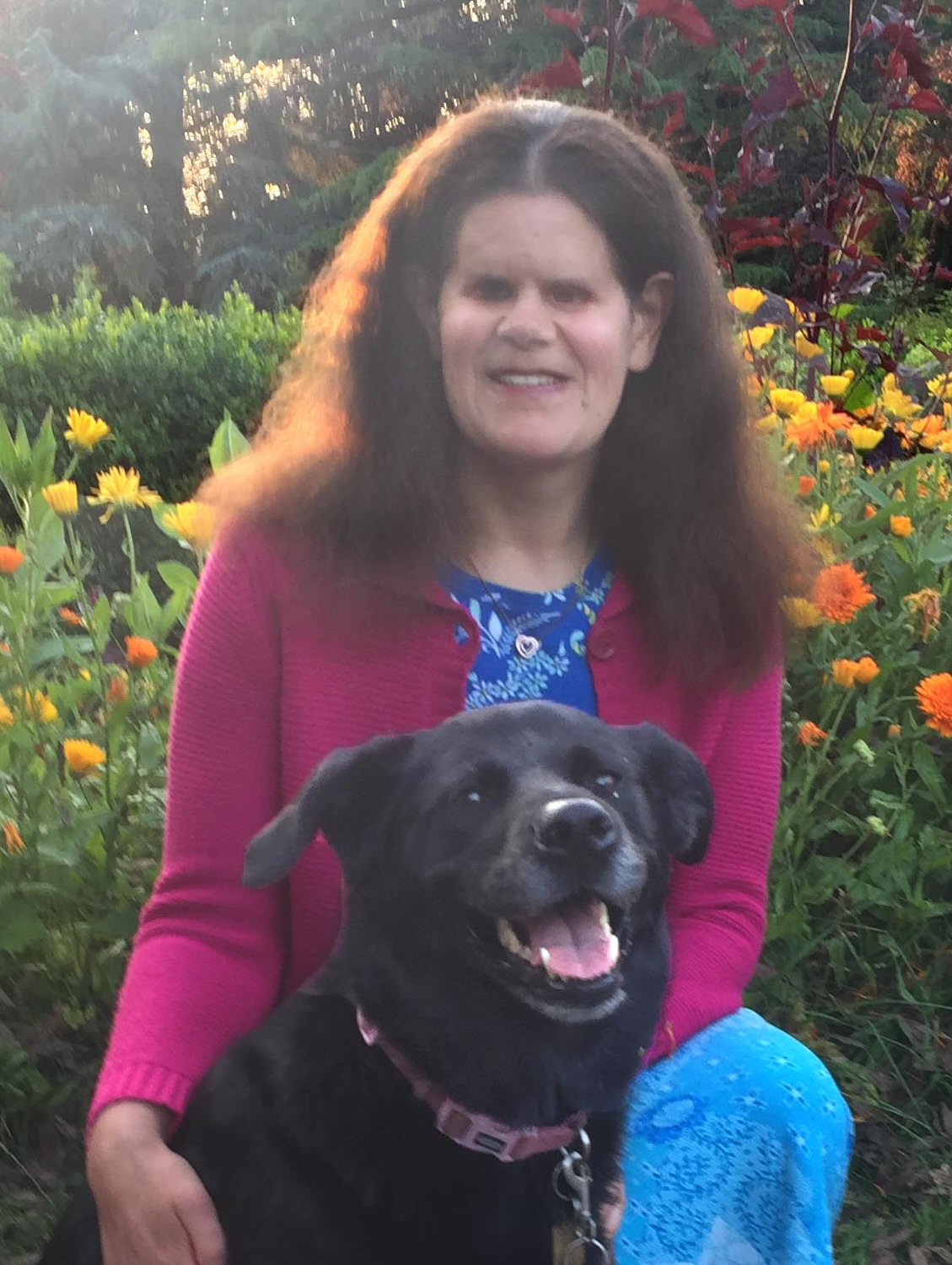From One Child to One Rb World: WE C Hope for Retinoblastoma Care
Monday March 4, 2024
In the first half of this article, we met Rati and Daisy, two young children with retinoblastoma who inspired the foundation of Daisy’s Eye Cancer Fund in 2004. In part 2, Rb Survivor and Daisy Fund co-founder, Abby White, reflects on what happened after Rati died – our journey to World Eye Cancer Hope (WE C Hope), One Rb World, and advocacy for all children, survivors and families.
Read Part 1: From One Child to One Rb World: Our Foundation Story
Many members of the KNRbS, during the 2009 meeting in Mombasa, which was held immediately before the annual congress of COECSA, the College of Ophthalmology of Eastern, Central, and Southern Africa.
The Kenya National Retinoblastoma Strategy
The Kenya National Rb Strategy (KNRbS) began in 2008, two years after Brenda Gallie (Rati’s Canadian doctor) and I first visited Kenya together.
The KNRbS group involves more than 50 ophthalmologists, ophthalmic clinical officers, oncologists, nurses, pathologists, pharmacists, social workers, child life leaders, scientists, parents, and survivors from across Kenya. Together, they continuously develop high quality retinoblastoma care.
A key goal of the strategy was collaborative development of evidence based clinical care guidelines, tailored to Kenya’s needs and resources. This is a slow process, requiring thorough literature searches and much group discussion until published evidence is identified or consensus reached to support each recommendation. The resulting guidelines provide a solid foundation for national standards of care, giving children the best possible chance of cure, quality of life, and lifelong care.
Daisy Fund facilitated collaboration through KNRbS 3-day annual meetings, together with Brenda Gallie and Dr. Helen Dimaras, Global Eye Health scientist at Toronto’s Hospital for Sick Children. Intense debate at these retreats led to agreement on contentious topics that lack solid evidence. For example, the use of orbital exenteration for children with retinoblastoma extending into the eye socket. After much discussion, the group reached consensus that exenteration is an ineffective and traumatic surgery to be avoided at all costs.
Here is a summary of the group’s progress:
2008: Identified all available clinical and supportive care resources across Kenya, challenges, priorities, and potential solutions to resolve access barriers and gaps in care.
2009: Began working on the Kenya National Guidelines for Retinoblastoma Care. Groups were formed to work on specific chapters covering awareness and education, screening, features and classification of Rb centres, referral and diagnosis, genetics, treatment, follow up, and psychosocial support.
2010-2012 Continued developing the guidelines. Recommendations were developed through intensive group sessions and discussion among the full delegation at annual meetings.
2013-2014: Integrated guidelines into medical practice cross the country.
2015: Kenyan Guidelines for Retinoblastoma Care were officially adopted by the Ministry of Health, and folded into the National Cancer Strategy. Kenya thus became only the second country to have adopted national guidelines for Rb care, along with Canada.
The guidelines will be regularly reviewed and updated to ensure they remain relevant and promote the best patient care. You can read the 2019 updated Kenyan Rb Care Guidelines at ACE-NCD – the African Research Universities Alliance (ARUA) Centre of Excellence for Non-Communicable Diseases.
Annual meetings also supported continued professional development and practical solutions through a mix of presentations, whole-group discussions, workshops, and small group activities. Subjects included early diagnosis strategies, all aspects of clinical care, psychosocial supports, and fundraising in Kenya to support development of Rb care.
Small-group activities helped participants to understand different parts of medical care from varied perspectives. Genetics and child life offer two examples.
Genetics Workshop
During a genetic counselling workshop, each group was given a different patient scenario and asked to role-play a consultation, explaining the scenario and its implications to the family or adult survivor. Each group performed their consultation to the entire delegation, prompting valuable discussion about the family’s potential experience and the role of genetic counselling in guiding patient care.
Knowledge increased and participants reported feeling more confident about discussing genetic counselling with patient families. Follow up research found that frequent refresher training supports knowledge retention and confident discussions for optimal patient care.
Child Life Workshop
During a child life practices workshop, small groups created storybooks and scripts for different medical procedures, explaining each step of the process in simple terms for both parent and child.
Participants found this helped them re-evaluate their experience of routine procedures from the perspective of a frightened child and overwhelmed parent, and consider simple ways to ease family distress. The practical session highlighted the value of working with child life specialists in the clinical setting to enhance patient care.
At every meeting, the KNRbS task forces (awareness, medical care, family support, and resource mobilisation) evaluated their achievements and challenges through the previous year, setting goals and tasks for the next twelve months. Each task force presented their outcomes and work-plan to the entire delegation for further discussion. A great deal of positive progress was made with this collaborative approach.
Dr. Kahaki Kimani, director of the Retinoblastoma Program at Kenyatta National Hospital, Nairobi, uses a Retcam to examine a child with eye cancer – its first use in clinical care.
Among many successes, Daisy Fund and the KNRbS:
- Developed early signs awareness information that was included in the Mother and Child Health Booklet (see p. 25), used by parents and primary healthcare workers nationwide. KEPI Nurses (Kenya Expanded Program for Immunization) were also trained to use this new content, and refer promptly if concerned.
- Implemented a referral protocol that hastens diagnosis and care.
- Brought the first Retcam to sub-Saharan Africa in 2009, in partnership with ORBIS and the manufacturer, Clarity Medical Systems. The Retcam allows high resolution imaging of a child’s eyes. Images can be viewed in real-time by all team members for collaborative exam, and reviewed by parents to aid decision-making. The imaging system supports telemedicine and training, and significantly enhances patient care.
- Established the Retinoblastoma Collaborative Laboratory (RbCoLab) in Nairobi, supporting telemedicine and enhanced care across treatment centres. Pathology slides can be scanned and viewed on a computer in ultrahigh resolution. Scanned images can be uploaded to the internet for collaborative review to ensure individualized patient care. Improved pathology and communication reduced turnaround time from more than 6 months to less than 2 weeks, guiding optimal post-operative care.
- Created a family support program, empowering caregivers to pay medical bills and other related costs, while staying with their hospitalized child. These family support activities are now provided by several local charities.
- Established Africa’s first child life training program, led by Morgan Livingstone CCLS, who worked with Daisy and Rati in Canada. Through this program, child life specialists in Kenya, Ghana, South Africa, and Malawi have become skilled providers of child and family psychosocial supports during potentially traumatic healthcare experiences.
On March 10, 2019, our beloved child life specialist Jayne Kamau died aboard Ethiopian Airlines flight ET302 as she returned home from the SIOP Africa conference in Cairo. Jayne was one of the first people to apply for child life training, leaving her secure job as a social worker. Over 11 years, she became one of the most effective advocates for child life supports in Africa.
Jayne died alongside two childhood cancer colleagues; researcher Dr. Grace Kariuki, and Hope for Cancer Kids family care coordinator, Bella Jaboma, with whom we had been working to expand child life supports in Nairobi. We miss Jayne, Bella and Grace immensely, and continue to advance child life and family support globally in their memory.
The KNRbS attracted significant support from prominent Kenyan healthcare leaders, including:
- Anyang’ Nyong’o, Minister for Medical Services 2008-13, lauded the ground-breaking partnership of public, private, and mission hospitals, and patient advocates to improve early diagnosis and access to expert care.
- Michael Gichangi, Director of Ophthalmic Services, Kenya Ministry of Health, and an active member of the KNRbS from its inception, celebrated the holistic approach to achieve effective eye cancer care and cure.
- Samson Ndegwa, Chair of Lions Loresho Eye Hospital in Nairobi, praised our unique collaborative approach to retinoblastoma that places the child and family at the centre of all we do.
Coordinated care has raised survival in Kenya from 26% in 2008 to 70% today. Following the path laid out by the KNRbS, Ghana is developing a comprehensive national strategy, and other countries are exploring options for a more collaborative approach to advance care and cure.
Kenya’s strategy offers a model for nationally coordinated Rb care in any country. Worldwide, collaboration can dramatically improve systematic awareness, delivery of evidence based care, and holistic family support.
This video showcases the child life training program at the Sally Test Paediatric Centre, Moi Teaching and Referral Hospital/Shoe4Africa Children’s Hospital in Eldoret, Kenya. It was created by our friends at AMPATH, Indiana University. The first voice you will hear is Jayne Kamau.
International Patient Care
Daisy Fund began with the funding of international care for one child. Since 2004, we have directly supported hundreds of families around the world, who struggled to access diagnosis, treatment or ongoing care in various ways. These include:
- Uninsured children and survivors.
- Families in conflict zones, from Afghanistan to central Africa.
- Families at Gaga (Chad) and Dadaab (Kenya) refugee camps, and the US/Mexico border.
- Children treated internationally, whose families could not meet the cost of ongoing follow-up care.
- Families in the midst of international or cross-country care when impacted by pandemic travel restrictions.
In 2023, I was invited to speak on international patient care at ISOO Africa – the first continental meeting of the International Society of Ocular Oncology, held August 19–21, 2023 in Mombasa, Kenya. Here is my pre-recorded talk.
I am regularly challenged by family and survivor needs as we cannot fund individual patients. We must focus our limited funds on programs that can make a lasting positive impact for many. Yet the child or adult survivor in front of me needs urgent care. The emotional burden of knowing the situation and not being able to meet their needs is heavy.
I also struggle with the outcome for children who travel internationally for care. Many do very well, their treatment life-saving, sometimes sight saving. But many return home with no follow up care, having invested everything in the treatment. Fundraising for active cancer therapy is like swimming through treacle. Fundraising for follow up care is akin to banging your head against a jagged stone.
So the child returns home to the mercy of chance – if the cancer relapses and there is no follow up care, what hope remains? Even when follow up care is available after eye-salvage, families are often convinced the eye can be saved; enucleation is sometimes refused until it is too late to cure the child.
Often the family turns to WE C Hope at this time, pleading for a miracle. I have seen too many children die due to lack of follow up after international eye-saving treatment.
I wonder how Rati would have fared, had she not relapsed, and returned to Botswana. I want to believe the careful planning with Princess Marina Hospital in Gaborone would have paid off, that she’d have received consistent follow up care. Experience tells me that is the exception, not the norm.
Sometimes, when I receive a parent’s frantic pleas, when graphic photos, medical reports, and socioeconomic circumstances tell the stark reality, I wish I had never responded to Salome’s first email. Guiding and supporting each family as they cast about for any shred of hope rips out my heart every time.
Equally challenging is the child diagnosed early – yet geography and poverty dictate their outcome before treatment begins. No local expertise; no support that could help the family consent to life-saving eye removal surgery; no funds to travel for eye-salvage therapy; funds for treatment but no follow up.
So the toddler diagnosed with unilateral Rb contained in their eye dies 3 years later from preventable metastasis. The child diagnosed at weeks old with cancer in both eyes and potential to save sight dies 10 years later due to undiagnosed relapse after years of bankrupting therapy in a developed country – the whole family devastated and pushed further into poverty.
When I feel burned out, I look at Rati’s photo, and remember the joy of her family reunion in Toronto. I remember her sweet laughter and the feel of my arms wrapped around her as we sat in the white rocking chair on the patio of our Give Kids The World villa. She was my child – she could be your child, and I know I cannot walk away.
No child should face these traumas, and no loved one should experience the ache of empty arms because of retinoblastoma. It is not my responsibility to save every child with Rb. But I can be part of the collective helping to give all children and survivors the best possible care.
Sera, from Fiji, had successful eye salvage therapy in Australia. When follow-up care fell apart due to lack of funds and unpaid hospital bills, her family contacted Daisy Fund for help. Here she is pictured in Brisbane, Australia, during care facilitated by Abby.
WE C Hope USA
After founding Daisy Fund, I received many requests for help from American families and survivors. No US non-profit offered tailored Rb support or advocacy. In 2011, I began investigating the options to fill this gap. Daisy’s Eye Cancer Fund USA was founded in 2012 to meet family and survivor needs, and encourage action to address the obstacles to highly effective care.
Just before official registration, our group was contacted by a young adult survivor seeking to serve the retinoblastoma community. Marissa Gonzalez became a much-valued founding board member. When Daisy Fund rebranded in 2015 to reflect our evolution, Marissa became President of the board of World Eye Cancer Hope USA.
Today, WE C Hope USA provides practical advice, advocacy and support across the country. Successes include:
- Working with families, hospitals, and agencies to ensure ongoing care during insurance and Medicaid disputes.
- Hosting family and survivor days/weekends in 7 regions, and virtual events, welcoming guests from 29 states in total. Virtual events have included a survivor meet-up; child life activity sessions; and a back-to-school session for parents, focused on practical supports and inclusive education planning for children with sight loss.
- Sponsoring Camp Sunshine Rb Week – a wonderful retreat including diagnosed children, siblings, and their caregivers.
- Establishing a growing collaboration with Know the Glow, a fabulous US non-profit working globally to educate about leukocoria and the 20+ childhood eye conditions it can indicate. Together, we advocate early detection and referral for prompt medical care.
In 2017, WE C Hope USA hosted the 4th One Rb World meeting, and the first National Rb Family and Survivor Day. These wonderful events brought together our global Rb community in Washington D.C., and accelerated the organization’s growth.
In August 2023, Marissa spoke about One Rb World at the ISOO Africa meeting in Mombasa, Kenya. Her experience in Africa led WE C Hope USA to fund donation of 300 Arclight ophthalmoscopes across 6 countries in Africa and Asia. Together with Know The Glow outreach to these countries, donation of the low-cost, high-tech eye screening devices will significantly enhance early detection of eye cancer and other vision-threatening conditions.
In October 2023, the New York Times featured Marissa in the Opinion Section cover story “It Takes a Lifetime to Survive Childhood Cancer”. This article drew significant attention to retinoblastoma and its lifelong impacts, across the USA and internationally.
WE C Hope USA has grown thanks to a small group of dedicated people dispersed across the country. Primarily parents and survivors, the team has persisted through many setbacks, including sight loss and second cancers. With broad experience of life with retinoblastoma, the team is well-placed to develop programs that will benefit families and survivors, and advance patient care across America, while also taking a leading role in global Rb advocacy.
Families and survivors at our 2023 Mid-Atlantic Rb Family Weekend gather outside the White House during a sightseeing tour of Washington D.C.
One Retinoblastoma World
When diagnosed early and treated appropriately, retinoblastoma is highly curable. No child should die, or suffer avoidable blindness from this cancer.
Awareness, medical care, family support, and research are all vital to cure and quality lifelong care. Just as fuel, heat and oxygen sustain a fire. Remove one element and the potential for a good outcome fades rapidly.
I observed that key parent and survivor priorities are not discussed at regular medical meetings. To address these priorities together as a global community, WE C Hope UK hosted the first One Rb World meeting in October 2012, immediately before the International Society of Paediatric Oncology (SIOP) world congress in London.
One Rb World unites all stakeholders to collaborate for the best possible acute and lifelong care worldwide. 60 medical professionals, scientists, and parent and survivor advocates from 26 countries on 6 continents participated in this unique foundational London meeting.
The One Rb World program combines presentations, round-table discussion, and small group work, each session co-led by a clinician and parent/survivor. The meeting encourages collaborative effort and networking to understand patient, survivor, and family needs, and build a solid foundation for relevant multi-centre research. Ultimately, advancing knowledge and scientific evidence will improve life, vision, and psychosocial outcomes for all.
In London, we also provided children’s activities, led by two Rb-survivor primary school teachers (Jana, and Steph – who died from orbital osteosarcoma in 2022). One Rb World’s child life program now empowers children to understand, engage with, and thrive through their Rb experiences.
Many participants at the first One Rb World meeting in London, 2012.
Since London 2012, five One Rb World meetings have been hosted by different institutions and organizations.
- 2014: Toronto, Canada – hosted by Retinoblastoma Program @ the Hospital for Sick Children (SickKids), and Daisy’s Eye Cancer Fund Canada.
- 2016: Dublin, Ireland – hosted by the Retinoblastoma Programs of Ireland and SickKids (Toronto).
- 2017: Washington D.C., USA – hosted by WE C Hope USA.
- 2020: Virtual – jointly hosted by the Canadian Rb Society, Canadian Rb Research Advisory Board (CRRAB), International Rb Consortium, and WE C Hope USA/Canada.
- 2021: Virtual – jointly hosted by WE C Hope USA and Dr. Sandra Staffieri, Rb Care Co-ordinator at the Royal Children’s Hospital Melbourne, Australia, representing Oceania’s Rb community.
Since 2017, we have livestreamed and recorded most sessions. You can view them at our One Rb World Sessions Hub.
WE C Hope USA is planning and hosting the 7th One Rb World meeting in Honolulu, Hawaii, 15-17 October 2024, immediately before the 56th SIOP World Congress (17-20 October). For the first time, the program will include a joint session with SIOP’s Paediatric Oncology in Developing Countries group.
SIOP’s world congress is the largest annual paediatric oncology meeting. Thousands of multi-disciplinary medical professionals and parent/survivor advocates from every corner of the globe gather to share and build knowledge for children with cancer, survivors, and their families.
This is an ideal forum for our worldwide community to advance whole-person care for all children, survivors, and families, and raise the profile of retinoblastoma within the wider childhood cancer arena.
World Eye Cancer Hope and One Rb World exist because of Rati. She died far too young, but her legacy continues to grow through our global village. This month, we celebrate the beautiful, bright, bubbly butterfly who came so briefly into our lives and challenged us to pay attention to children’s suffering. And in October, One Rb World will continue to move patient care forward, exactly 20 years on from her arrival in Canada.
Together, we can save lives, create safe sight-saving opportunities, and reduce unnecessary suffering. Every step forward is a thumbs up to our beloved little Rati.
“E Komo Mai” means “welcome” in Hawaiian. At the airport, and at the entrance to businesses, organizations, and homes across the State, this warm greeting invites people to feel part of a shared community, conversation, and sense of belonging.
This is the core spirit of One Rb World! Please join us at One Rb World 2024 in Hawaii to connect with others and share life-changing hope with children, survivors, families, and all who care for them.
About the Author
Abby’s father was diagnosed with bilateral retinoblastoma in Kenya in 1946. Abby was also born with cancer in both eyes. She has an artificial eye and limited vision in her left eye that is now failing due to late effects of radiotherapy in infancy.
Abby studied geography at university, with emphasis on development in sub-Saharan Africa. She co-founded WE C Hope with Brenda Gallie, responding to the needs of one child and the desire to help many in developing countries. After receiving many requests for help from American families and adult survivors, she co-founded the US chapter to bring hope and encourage action across the country.
Abby enjoys listening to audio books, creative writing, open water swimming and long country walks.
You May Also Like…
International Care: Challenges and Opportunities
Families and medical professionals worldwide seek retinoblastoma care at centres offering treatments that are unavailable in their home country. Many families contact WE C Hope for assistance before, during or after such treatment. Abby White explores the challenges they experience and what can be done to help improve outcomes for their children.
Perfect Vision: Care and Cure for Children with Eye Cancer in Developing Countries
Retinoblastoma is highly curable with early diagnosis and modern therapies. But 90% of affected children live in developing countries, and globally, less than 3 in 10 children survive. Rb survivor and volunteer CEO, Abby White, explores the biggest challenges to care in developing countries, and some ways to overcome them.
Child Life in Kenya: The Sally Test Child Life Program
Children with cancer experience invasive procedures and stressful events throughout their medical care that can impact their ability to cope, inhibit their development and negatively affect their health and well-being throughout life. Child life supports effective healthcare and reduces trauma. Morgan Livingstone CCLS describes how WE C Hope is bringing hope through Child Life to children and their families in Africa.
Ethnography: A New Frontier in Retinoblastoma Research
Every child with retinoblastoma, parent, sibling, survivor, and medical professional has a story to tell of their journey through childhood eye cancer. Understanding our individual and collective experience empowers us to develop and deliver holistic care for all. Rb survivor and WE C Hope USA Director, Clayonia Colbert-Dorsey discusses the growing field of ethnography research, and how it can positively impact our diverse global community.
Capture the Moment at One Retinoblastoma World 2024 in Hawaii
One Retinoblastoma World is community, conversation and collaboration for the best lifelong Rb care and support. Previous participants share why the event is so valuable. Rb survivor and WE C Hope CEO, Abby White, considers the many benefits of participating in person compared to attending online, and some ways we can travel “kuleana” to the conference.









Leave a Reply
Want to join the discussion?Feel free to contribute!